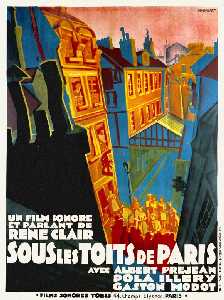 |
| Jacques Feyder |
Belgian-born director Jacques Feyder established his career in France during the silent era, and went to work for MGM in Hollywood in 1929 to direct Greta Garbo in her last silent movie,
The Kiss. But Hollywood was more interested in having him direct foreign-language versions of movies after talkies came in: Before dubbing became a common practice, films were often made in two versions, one in English for the American and British markets, others in various languages for overseas audiences. So Feyder was tasked with making a German-language version of Garbo's first talkie,
Anna Christie (1931), though he also made two movies starring Ramon Novarro,
Daybreak (1931) and
Son of India (1931). Disillusionment with Hollywood sent him back to France, where he made his most famous film,
Carnival in Flanders, in 1935. The rise of the Nazis, who banned that film after they invaded France in 1940, caused Feyder and his wife, Françoise Rosay, who starred in many of his movies, to move to Switzerland, where his career stalled and he died, only 62, in 1948. After the New Wave filmmakers began to dominate French film, Feyder's reputation began to wane: François Truffaut said of
Carnival in Flanders that it represented a tendency to make everything "pleasant and perfect," As a result, David Thomson has said, "Feyder may be unfairly neglected today just as once he was injudiciously acclaimed."
Gribiche (Jacques Feyder, 1926)

The young actor Jean Forest had been discovered by Feyder and his wife, Françoise Rosay, and he starred in three films for the director, of which this was the last. It's a peculiar fable about charity. Forest plays Antoine Belot, nicknamed "Gribiche," who sees a rich woman, Edith Maranet (Rosay), drop her purse in a department store and returns it to her, spurning a reward. Edith is a do-gooder full of theories about "social hygiene." Impressed by the boy's honesty, Edith goes to his home, a small flat above some shops, where he lives with his widowed mother, Anna (Cécile Guyon), and proposes that she adopt Gribiche and educate him. Anna is reluctant to give up the boy, but Gribiche, knowing that Anna is being courted by Phillippe Gavary (Rolla Norman), and believing that he stands in the way of their marriage, agrees to the deal. When her rich friends ask about how she found Gribiche, Edith tells increasingly sentimental and self-serving stories -- dramatized by Feyder -- about the poverty in which she found him and his mother. But the boy is unhappy with the cold, sterile environment of Edith's mansion and the regimented approach to his education, and on Bastille Day, when the common folk of Paris are celebrating in what Edith regards as "unhygienic" ways, he finds his way back to his mother's home. Edith is furious, but eventually is persuaded to see reality and agrees to let him live with Anna and Phillippe, who have married, while she pays for his education. The whole thing is implausible, but the performances of Forest and Rosay, and especially the production design by Lazare Meerson, make it watchable and occasionally quite charming.
Carnival in Flanders (Jacques Feyder, 1935)
Feyder's best-known film is something of a feminist fable, a kind of inversion of
Lysistrata, in which the women of Boom, a village in 17th century Flanders that is occupied by the Spanish save the town from the pillage and plunder that the men of the village expect. Françoise Rosay plays the wife of the burgomaster (André Alerme), who holes up in his house, pretending to have died. The other officials of the town likewise sequester themselves. But the merry wives of Boom decide to wine, dine, and otherwise entertain the occupying Spaniards. It's all quite saucily entertaining, though undercut by a tiresome subplot (suspiciously reminiscent of that in Shakespeare's own play about merry wives) involving the burgomaster's daughter (Micheline Chierel) and her love for the young painter Julien Brueghel (Bernard Lancret), of whom the burgomaster disapproves. Again, Rosay's performance is a standout, as is Lazare Meerson's design: The village, with its evocation of the paintings of the Flemish masters, was created in a Paris suburb, with meticulous attention to detail, including the men's unflattering period costumes, designed by Georges K. Benda. The cinematography is by the American Harry Stradling Sr., who built his reputation in Europe before returning to Hollywood.






